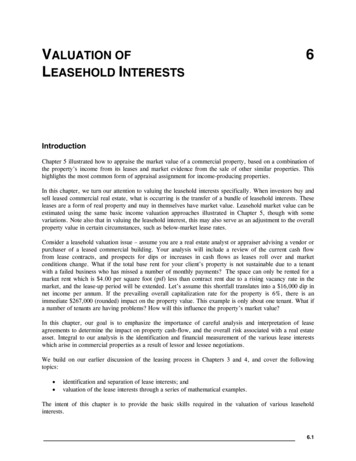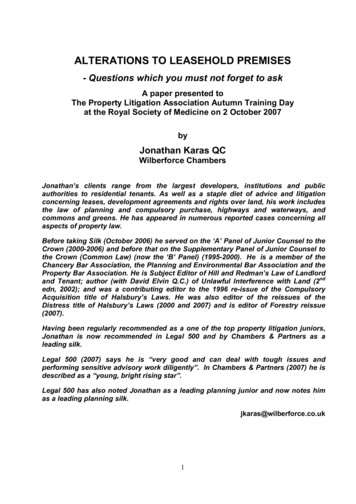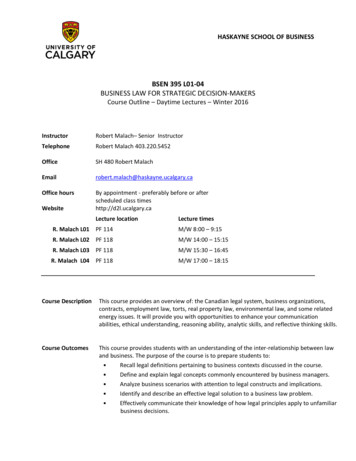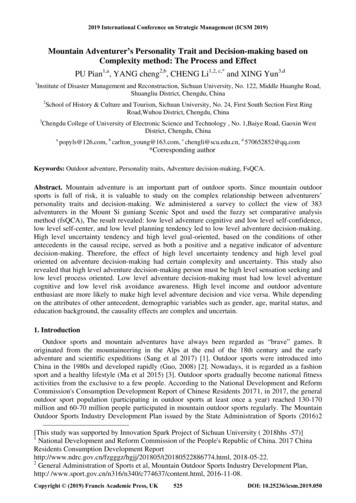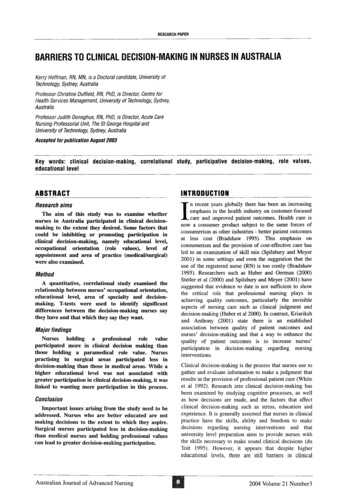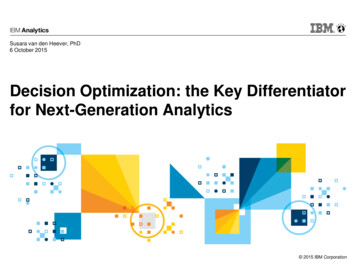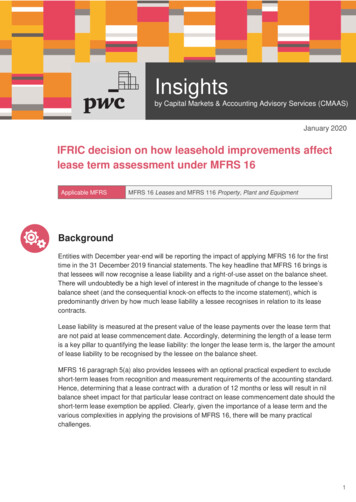
Transcription
Insightsby Capital Markets & Accounting Advisory Services (CMAAS)January 2020IFRIC decision on how leasehold improvements affectlease term assessment under MFRS 16Applicable MFRSMFRS 16 Leases and MFRS 116 Property, Plant and EquipmentBackgroundEntities with December year-end will be reporting the impact of applying MFRS 16 for the firsttime in the 31 December 2019 financial statements. The key headline that MFRS 16 brings isthat lessees will now recognise a lease liability and a right-of-use asset on the balance sheet.There will undoubtedly be a high level of interest in the magnitude of change to the lessee’sbalance sheet (and the consequential knock-on effects to the income statement), which ispredominantly driven by how much lease liability a lessee recognises in relation to its leasecontracts.Lease liability is measured at the present value of the lease payments over the lease term thatare not paid at lease commencement date. Accordingly, determining the length of a lease termis a key pillar to quantifying the lease liability: the longer the lease term is, the larger the amountof lease liability to be recognised by the lessee on the balance sheet.MFRS 16 paragraph 5(a) also provides lessees with an optional practical expedient to excludeshort-term leases from recognition and measurement requirements of the accounting standard.Hence, determining that a lease contract with a duration of 12 months or less will result in nilbalance sheet impact for that particular lease contract on lease commencement date should theshort-term lease exemption be applied. Clearly, given the importance of a lease term and thevarious complexities in applying the provisions of MFRS 16, there will be many practicalchallenges.1
Insightsby Capital Markets & Accounting Advisory Services (CMAAS)What is the issue?This article looks at the November 2019 Agenda Decision* by the IFRS InterpretationsCommittee (the “IC”) published in December 2019. Consider the following scenario, adaptedfrom the questions submitted to the IC for consideration:ScenarioCancellable leaseCompany A (the lessor) enters into a lease contract with Company B (the lessee) with detailsas follows: the lease contract does not specify a particular contractual term and continuesindefinitely until either Company A (the lessee) or Company B (the lessor) givesnotice to terminate if either the lessee or lessor gives notice, the lease continues for a period of 12months (‘notice period’) until termination neither party is obliged to make a contractual payment on terminationRenewable leaseCompany A (the lessor) enters into a lease contract with Company B (the lessee) where thelease contract specifies an initial period that renews indefinitely unless terminated by eitherthe lessee or lessor.In both leases, assume that Company A (the lessee) has installed non-removable leaseholdimprovements at the leased asset. The leasehold improvements have an estimatedeconomic life which exceeds 12 months.Given the scenario above, the IC was asked the following two questions:1. How should the lease term of a cancellable lease or a renewable lease bedetermined?2. Would the useful life of related non-removable leasehold improvements be limited tothe lease term?* The IC works with the International Accounting Standards Board in supporting consistency in application of IFRS Standards(Malaysian Financial Reporting Standards issued by MASB are equivalent to IFRS Standards). IC agenda decisions often includeinformation to help entities in applying IFRS Standards. They do so by explaining how the applicable principles and requirements inthe IFRS Standards apply to the application question described in the agenda decision.2
Insightsby Capital Markets & Accounting Advisory Services (CMAAS)What are the principles for determining lease term underMFRS 16?To work out the lease term, it is useful to return to the basic MFRS 16 principles, summarisedin the following table:Source: IC Agenda Decision Paper 4 (November 2019)The “non-cancellable period” effectively sets the minimum period which the lessee mustrecognise as the lease term (where the lease rentals of the period are recognised as part ofthe lease liability), whilst the “enforceable period”, being the period for which enforceablerights and obligations exist between the lessee and the lessor, can be seen as the maximumperiod which the lessee may consider as the lease term. In particular, MFRS 16 paragraphB34 states that a lease would no longer be enforceable when the lessee and lessor each hasthe right to terminate the lease without permission from the other party with no more than aninsignificant penalty.Beyond the enforceable period, there is no contractually binding lease between the lesseeand lessor since neither party can enforce their rights and obligations on each other, whichwould simply mean that from the lessee’s perspective there is no lease liability to account for.Essentially, the “lease term” will be a period of time that sits somewhere in between thenon-cancellable period and the enforceable period. This is because in practice, if there areany options to extend or terminate the lease term, the lease term is clearly an area ofjudgment.3
Insightsby Capital Markets & Accounting Advisory Services (CMAAS)What are the principles for determining lease term underMFRS 16? (continued)The lessee would need to consider all relevant facts and circumstances that create aneconomic incentive for the lessee to exercise an option to extend the lease, or not toexercise an option to terminate the lease (MFRS 16 paragraph 9). MFRS 16 paragraph B37provides a list of non-exhaustive examples of such relevant facts and circumstances to beconsidered (MFRS 16 paragraph B37): how do contractual terms and conditions for optional periods compare with marketrates;whether any significant leasehold improvements have been undertaken;are there any costs associated with termination;the importance of the underlying asset that is being leased to the lessee’s business;andwhether there is any further conditionality associated with exercising an option.Of course, the lease term may very well be identical to the non-cancellable period and theenforceable period, for example in a lease agreement that binds both the lessee and lessorfor a duration of 5 years and neither party has any option to extend or terminate.What is the IC’s Agenda Decision?Now that we have recapped the core principles for determining a lease term under MFRS 16,let us revisit the questions submitted to the IC in relation to a cancellable or renewable leaseand the IC's deliberation on these issues.Determining the lease term of a cancellable or renewable leaseIFRS 16 does not define “penalty” or “enforceable”, both words included in paragraph B34 ofIFRS 16. The IC observed that, in applying IFRS 16 paragraph B34, an entity considers thebroader economics beyond the contractual termination payments between lessee and lessor.If either party will incur a more than insignificant penalty (including economic penalties) fromterminating, the lease is enforceable beyond that date. Once the enforceable period hasbeen determined, the lessee applies the guidance on lessee extension / termination optionsto determine the lease term i.e. if the lessee is reasonably certain to continue using theasset, the periods are included in the lease term.4
Insightsby Capital Markets & Accounting Advisory Services (CMAAS)What is the IC’s Agenda Decision? (continued)Now that we have recapped the core principles for determining a lease term under MFRS 16,let us revisit the questions submitted to the IC in relation to a cancellable or renewable leaseand the IC's deliberation on these issues.Determining the lease term of a cancellable or renewable leaseIFRS 16 does not define “penalty” or “enforceable”, both words included in paragraph B34 ofIFRS 16. The IC observed that, in applying IFRS 16 paragraph B34, an entity considers thebroader economics beyond the contractual termination payments between lessee and lessor.If either party will incur a more than insignificant penalty (including economic penalties) fromterminating, the lease is enforceable beyond that date. Once the enforceable period hasbeen determined, the lessee applies the guidance on lessee extension / termination optionsto determine the lease term i.e. if the lessee is reasonably certain to continue using theasset, the periods are included in the lease term.Determining the useful life of non-removable leasehold improvementsThe IC was also asked whether the useful life of the non-removable leasehold improvementwould be limited to the lease term. That is, if the lease term is determined to be the noticeperiod of 12 months or less, then the useful life of the leasehold improvements would followthat period.The IC noted that IAS 16 Property, Plant and Equipment (MFRS 116 is equivalent) explainsthat “useful life” is the period over which an asset is expected to be available for use by theentity and IAS 16 specifies that in determining the useful life of an asset, an entity considersany ‘legal or similar limits on the use of the asset, such as the expiry dates of related leases’and useful life of an asset may be shorter than its economic life.In responding to the question posed, the IC indicated that if the lease term of the relatedlease is shorter than the economic life of those non-removable leasehold improvements, thelessee should consider whether it expects to use the leasehold improvements beyond thatlease term. If the lessee does not expect to use the leasehold improvements beyond thelease term of the related lease then, applying IAS 16, the lessee should conclude that theuseful life of the non-removable leasehold improvements is the same as the lease term. TheIC observed that, , an entity might often reach this conclusion for leasehold improvementsthat the entity will use and benefit from only for as long as it uses the underlying asset in thelease.5
Insightsby Capital Markets & Accounting Advisory Services (CMAAS)What is the IC’s Agenda Decision? (continued)Interaction between lease term and useful life of non-removable leaseholdimprovementsBased on the IC’s observation, the existence of any non-removable leasehold improvementis critical and linked to assessing the enforceable period of the cancellable or renewablelease. The broader economics of the contract should be considered when determining theenforceable period of the lease. If a lessee expects to use non-removable leaseholdimprovements beyond the date on which the contract can be terminated, the existence ofthose leasehold improvements indicates that the lessee might incur a more than insignificantpenalty if it terminates the lease. Even though the lessee need not make any terminationpayments to the lessor, the lessee would suffer a penalty of giving up its ability to fully utilisethe leasehold improvements, such as costs of abandoning or dismantling non-removableleasehold improvements. Consequently, applying MFRS 16 paragraph B34, a lessee shouldconsider whether the contract is enforceable for at least the period of expected utility of theleasehold improvements.What is the impact and for whom?Entities which had previously interpreted MFRS 16 paragraph B34 differently, for exampleonly considering contractual termination payments as penalties, will need to re-assess thelease term for their leases. Using a broader interpretation of penalty, some leases will have alonger enforceable period. If there are longer enforceable periods and the lessee isreasonably certain to continue using the asset, it will result in a longer lease term andtherefore larger lease liabilities for the lessee.6
Insightsby Capital Markets & Accounting Advisory Services (CMAAS)When does it apply?The agenda decision has no formal effective date. The IC has noted that agenda decisionsmight often result in explanatory material that was not previously available, which might causean entity to change an accounting policy. Entities are therefore encouraged to apply theAgenda Decision as part of the implementation of MFRS 16 where possible.In situations where entities might not have sufficient time to implement the changes by 31December 2019, particularly if they have a large volume of leases with different terms andconditions, entities may apply the Agenda Decision at a future point in time by way of achange in accounting policy. When the change in policy is implemented, it should be appliedretrospectively, and comparative amounts should be restated. When management hasconcluded that a change in an accounting policy is required as a result of an agenda decisionbut that change has not been made yet, they should consider providing disclosures similar tothose provided about forthcoming standards in accordance with paragraphs 30 and 31 ofMFRS 108 Accounting Policies, Changes in Accounting Estimates and Errors.Do you need furtherinformation on thistopic?Refer to the IC’s Agenda Decision here; orContact: Foo Wee Liam Assurance Director from PwC Malaysia CMAASEmail: foo.weeliam@pwc.com Tel: 60 (3) 2173 0620Stay up to date withthe latestdevelopments infinancial reportingand capital marketsCMAAS’s monthly newsletter "Accounting & Capital Markets Round-Up"features 3 hot topics written in a way that you can easily access.Click on this link to subscribe and receive the newsletter in your inbox as soonas it is released each month. The newsletter is accessible via mobile phoneas well.This content is for general information purposes only and should not be used as a substitute for consultation with professionaladvisors. 2020 PricewaterhouseCoopers Risk Services Sdn Bhd. All rights reserved. "PricewaterhouseCoopers” and/or “PwC” refers tothe individual members of the PricewaterhouseCoopers organisation in Malaysia, each of which is a separate and independentlegal entity. Please see www.pwc.com/structure for further details.7
those leasehold improvements indicates that the lessee might incur a more than insignificant penalty if it terminates the lease. Even though the lessee need not make any termination payments to the lessor, the lessee would suffer a penalty of giving up its ability to fully utilise the leasehold improvements, such as costs of abandoning or dismantling non-removable leasehold improvements .
